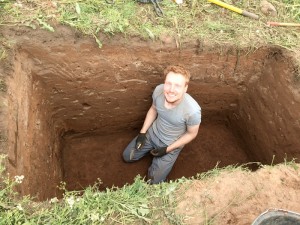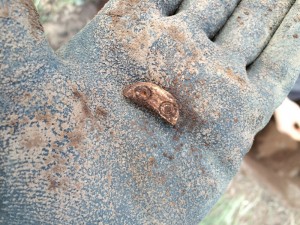For the past three days, we have been excavating a 1x2m test pit at Ás to determine the date of the earliest occupation of the site as determined by the presence of cultural material in relation to the tephra layers, as well as to understand the formation of the farm mound. Ás was one of the richest farms in Hegranes and one of the most important farms owned by the Ásbirningar clan, which controlled much of Skagafjörður in the 12th and 13th centuries. Most of the manmade materials, including glass and ceramics, are limited to the topsoil.
We reached the 1300 tephra at around a meter deep. Below it we had bone-filled midden (which I as a zooarchaeologist am super excited about!). Although some of the bone was decomposing, we were able to identify bones from sheep/goats, cows, horses, pigs, and an as yet unidentified bird. Immediately beneath the pre-1300 midden was what appeared to be a ground surface, in which the number of bones dropped off sharply. It was in this context that we discovered a decorative ivory artifact. Since we have not encountered the 1104 tephra layer yet, we can probably assume that it came from the time period between 1104 and 1300 AD. It is around the width of a quarter with incised decorations. Our best guess as to what is was right now is a fragment of an ivory comb.
…. Katie Wagner


